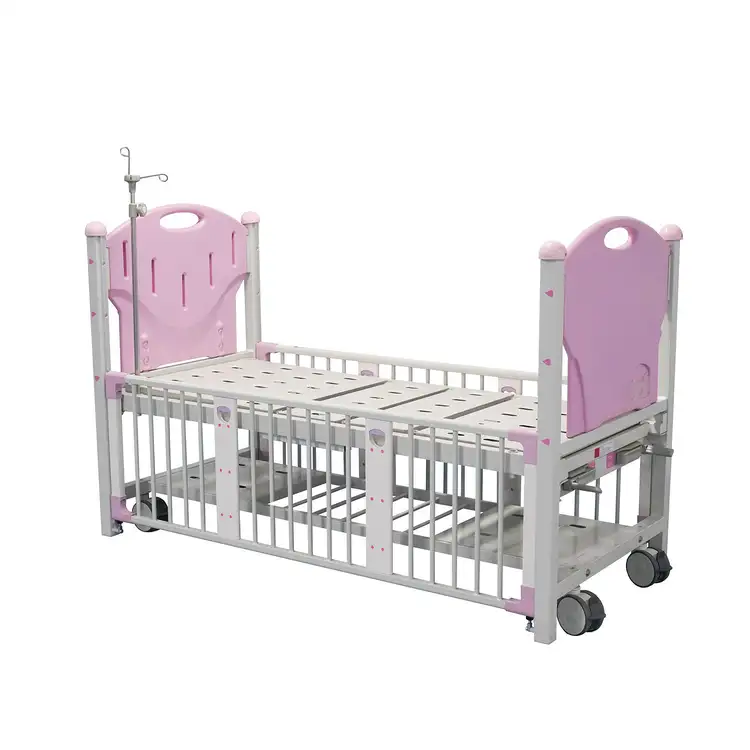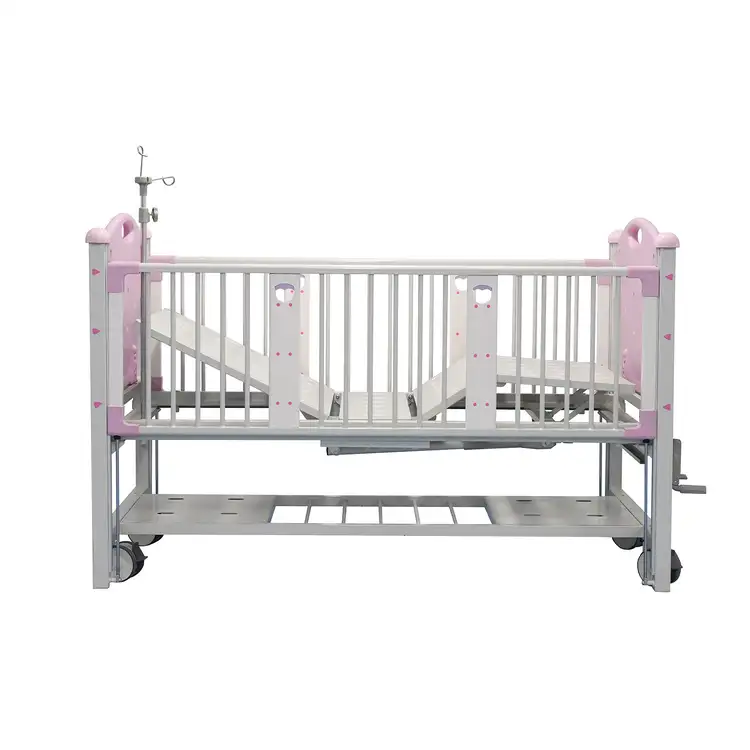Indirizzo
304 Il cardinale nord S.
Dorchester Center, MA 02124
Ore di lavoro
Dal lunedì al venerdì: 7:00 - 19:00
Fine settimana: 10:00 - 17:00
Indirizzo
304 Il cardinale nord S.
Dorchester Center, MA 02124
Ore di lavoro
Dal lunedì al venerdì: 7:00 - 19:00
Fine settimana: 10:00 - 17:00

Un letto pediatrico in ospedale svolge un ruolo fondamentale nel garantire che i bambini ricevano le cure di cui hanno bisogno in un ambiente sicuro e confortevole.
Benvenuti nel mio blog!
Prima di immergerci nei contenuti, mi piacerebbe che ti unissi a me sulle mie piattaforme social, dove condivido altre intuizioni, interagisco con la community e pubblico aggiornamenti. Ecco come puoi metterti in contatto con me:
Facebook:https://www.facebook.com/profile.php?id=100071234835011
LinkedIn:https://www.linkedin.com/company/74943205/admin/dashboard/
YouTube:https://www.youtube.com/@shandongexpertmedicalequip4695
TikTok:https://www.tiktok.com/@expertmedical
Ora, iniziamo il nostro viaggio insieme. Spero che tu trovi il contenuto qui perspicace, coinvolgente e prezioso.
Quando si tratta di assistenza pediatrica, il benessere e il comfort dei piccoli pazienti sono di fondamentale importanza. Un letto pediatrico ospedaliero svolge un ruolo cruciale nel garantire che i bambini ricevano le cure di cui hanno bisogno in un ambiente sicuro e confortevole. I pazienti pediatrici hanno esigenze specifiche e i letti ospedalieri standard potrebbero non essere adatti alle loro esigenze. Ecco perché ogni struttura sanitaria, che si tratti di un ospedale pediatrico, di un ospedale generale o di un centro di assistenza specialistica, deve investire in letti pediatrici ospedalieri di qualità.
In questo blog esploreremo l'importanza dei letti pediatrici nell'assistenza sanitaria, le caratteristiche essenziali di un letto pediatrico ospedaliero e perché sono indispensabili per garantire la migliore assistenza ai piccoli pazienti.

I letti pediatrici ospedalieri sono progettati specificamente per soddisfare le esigenze fisiche ed emotive dei pazienti più piccoli. A differenza dei letti ospedalieri per adulti, questi letti sono realizzati per adattarsi alle dimensioni e al peso dei bambini, dai neonati agli adolescenti. I letti pediatrici sono spesso dotati di altezze regolabili, sponde laterali e materassi speciali che garantiscono comfort e sicurezza.
Oltre alle caratteristiche di sicurezza, molti letti pediatrici sono progettati per essere visivamente accattivanti per i bambini. Colori vivaci, design adatti ai bambini ed elementi giocosi possono contribuire a ridurre l'ansia e rendere la degenza ospedaliera meno intimidatoria per i piccoli pazienti.
La sicurezza è una priorità assoluta quando si tratta di assistenza pediatrica e i letti pediatrici ospedalieri sono dotati di diverse misure di sicurezza per proteggere i piccoli pazienti. Queste caratteristiche includono:
Queste misure di sicurezza sono fondamentali per prevenire incidenti e garantire la sicurezza dei bambini durante la degenza in ospedale.
Il comfort è un fattore chiave nell'assistenza pediatrica e i letti pediatrici ospedalieri sono progettati per offrire il massimo comfort ai piccoli pazienti. I materassi utilizzati in questi letti sono spesso progettati per garantire al bambino un sostegno e un comfort ottimali durante tutta la degenza. Materassi in memory foam o imbottiture antidecubito sono comunemente utilizzati per ridurre al minimo il disagio, soprattutto per i bambini costretti a letto per periodi prolungati.
Oltre al comfort fisico, anche il supporto emotivo è importante. Letti pediatrici con design divertenti o elementi interattivi possono creare un ambiente più accogliente per i bambini. La degenza in ospedale può essere un'esperienza stressante per i piccoli pazienti, e avere un letto che li faccia sentire al sicuro e a loro agio può contribuire ad alleviare parte dell'ansia che potrebbero provare.
| Caratteristica | Letto ospedaliero standard | Letto pediatrico ospedaliero |
|---|---|---|
| Dimensioni del letto | Progettato per adulti | Dimensioni più piccole per adattarsi ai bambini |
| Sponde laterali | Altezza di base | Alto, regolabile per sicurezza |
| Tipo di materasso | Materasso standard ospedaliero | Adatto ai bambini, anti-pressione |
| Progettazione visiva | Neutro o clinico | Design luminosi e adatti ai bambini |
| Caratteristiche di sicurezza | Minimo | Maggiore sicurezza per i bambini |
| Adattabilità | Regolazione standard | Completamente regolabile per i bambini |
Questa tabella evidenzia le principali differenze tra un letto ospedaliero standard e un letto pediatrico ospedaliero. Sebbene entrambi svolgano la funzione primaria di supportare i pazienti durante la degenza ospedaliera, i letti pediatrici sono specificamente progettati per soddisfare le esigenze dei bambini in termini di sicurezza, comfort e benessere emotivo.

Il vantaggio principale dell'investimento in letti pediatrici ospedalieri di qualità è la maggiore sicurezza che offrono. Poiché i bambini sono più vulnerabili ad incidenti e lesioni, i letti pediatrici con caratteristiche di sicurezza avanzate come sponde laterali regolabili, regolazione dell'altezza e meccanismi di bloccaggio sicuri sono essenziali per prevenire cadute e altri incidenti.
Inoltre, i letti pediatrici di alta qualità sono realizzati con materiali resistenti in grado di sopportare i movimenti attivi dei bambini, garantendo stabilità e sicurezza anche in situazioni ad alto consumo energetico. Questo livello di sicurezza non è solo rassicurante per chi si prende cura dei bambini, ma anche per le famiglie dei piccoli pazienti, che desiderano garantire che il loro bambino viva in un ambiente sicuro.
I bambini in fase di recupero da una malattia o un intervento chirurgico hanno bisogno di riposare comodamente e un letto pediatrico ospedaliero di alta qualità può migliorare significativamente il loro comfort durante il processo di guarigione. I materassi specializzati utilizzati nei letti pediatrici sono progettati per sostenere il corpo del bambino, riducendo i punti di pressione e prevenendo fastidi o piaghe da decubito.
Il comfort è strettamente correlato al recupero e un paziente ben riposato ha maggiori probabilità di guarire più rapidamente. Offrendo un ambiente di sonno confortevole e sicuro, i letti pediatrici contribuiscono a migliorare la salute dei piccoli pazienti.
Gli ospedali possono essere intimidatori, soprattutto per i bambini che potrebbero non comprendere appieno ciò che accade intorno a loro. Letti pediatrici ospedalieri con design a misura di bambino ed elementi rassicuranti possono contribuire a creare un ambiente più positivo e rilassante per i piccoli pazienti. Colori vivaci, grafiche divertenti e design interattivi possono rendere l'ospedale meno ansioso e più accogliente, riducendo stress e ansia.
Inoltre, i letti pediatrici progettati pensando al comfort aiutano i bambini a sentirsi più a loro agio, il che può portare a una migliore collaborazione con le procedure mediche e a un'esperienza complessiva più positiva.
Investire in letti pediatrici ospedalieri di qualità è essenziale per le strutture sanitarie che si occupano di pazienti giovani. Questi letti offrono caratteristiche di sicurezza essenziali, maggiore comfort e supporto emotivo, tutti elementi che contribuiscono a migliorare l'esperienza complessiva dei bambini ricoverati in ospedale. Che si tratti di cure generali, recupero post-operatorio o trattamenti pediatrici specialistici, un letto pediatrico ospedaliero è uno strumento fondamentale per garantire il benessere dei piccoli pazienti.
Scegliendo il letto pediatrico giusto, gli operatori sanitari possono creare un ambiente più sicuro, più confortevole e di supporto emotivo che non solo favorisce il processo di recupero, ma aiuta anche i bambini a sentirsi più a loro agio durante la degenza in ospedale.
I letti pediatrici ospedalieri sono progettati specificamente per i bambini, offrendo caratteristiche come dimensioni ridotte, sponde di sicurezza regolabili e design a misura di bambino, che in genere non si trovano nei letti ospedalieri standard. Queste caratteristiche garantiscono ai pazienti pediatrici sicurezza, comfort e supporto emotivo durante la degenza.
Le principali caratteristiche di sicurezza da ricercare in un letto pediatrico ospedaliero includono sponde laterali regolabili in altezza, regolazione dell'altezza, struttura robusta e bordi arrotondati. Queste caratteristiche contribuiscono a prevenire le cadute, a garantire facilità di cura e a creare un ambiente più sicuro per i piccoli pazienti.
I letti pediatrici ospedalieri migliorano l'esperienza ospedaliera del bambino offrendo comfort, sicurezza e un ambiente più accogliente. Letti progettati con grafiche divertenti ed elementi a misura di bambino possono ridurre l'ansia, mentre caratteristiche come i materassi antidecubito garantiscono il comfort fisico durante la degenza.
Sì, molti letti pediatrici ospedalieri sono progettati per essere regolabili e adattarsi a bambini di diverse età e corporature. Caratteristiche come l'altezza regolabile del letto e le sponde laterali consentono agli operatori sanitari di adattare il letto alle esigenze specifiche del paziente.
Offrendo un ambiente confortevole e sicuro, i letti pediatrici ospedalieri favoriscono una guarigione più rapida. I materassi specializzati aiutano ad alleviare i punti di pressione, mentre le caratteristiche di sicurezza prevengono incidenti che potrebbero ostacolare il processo di guarigione.